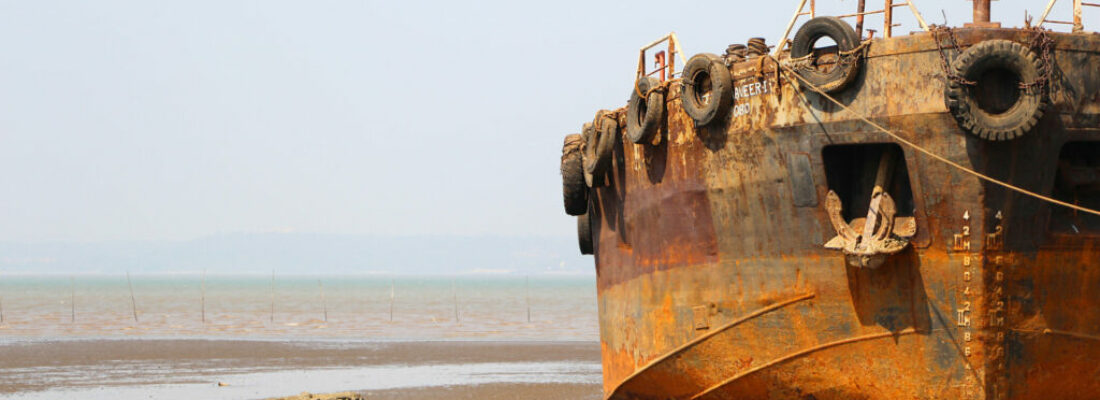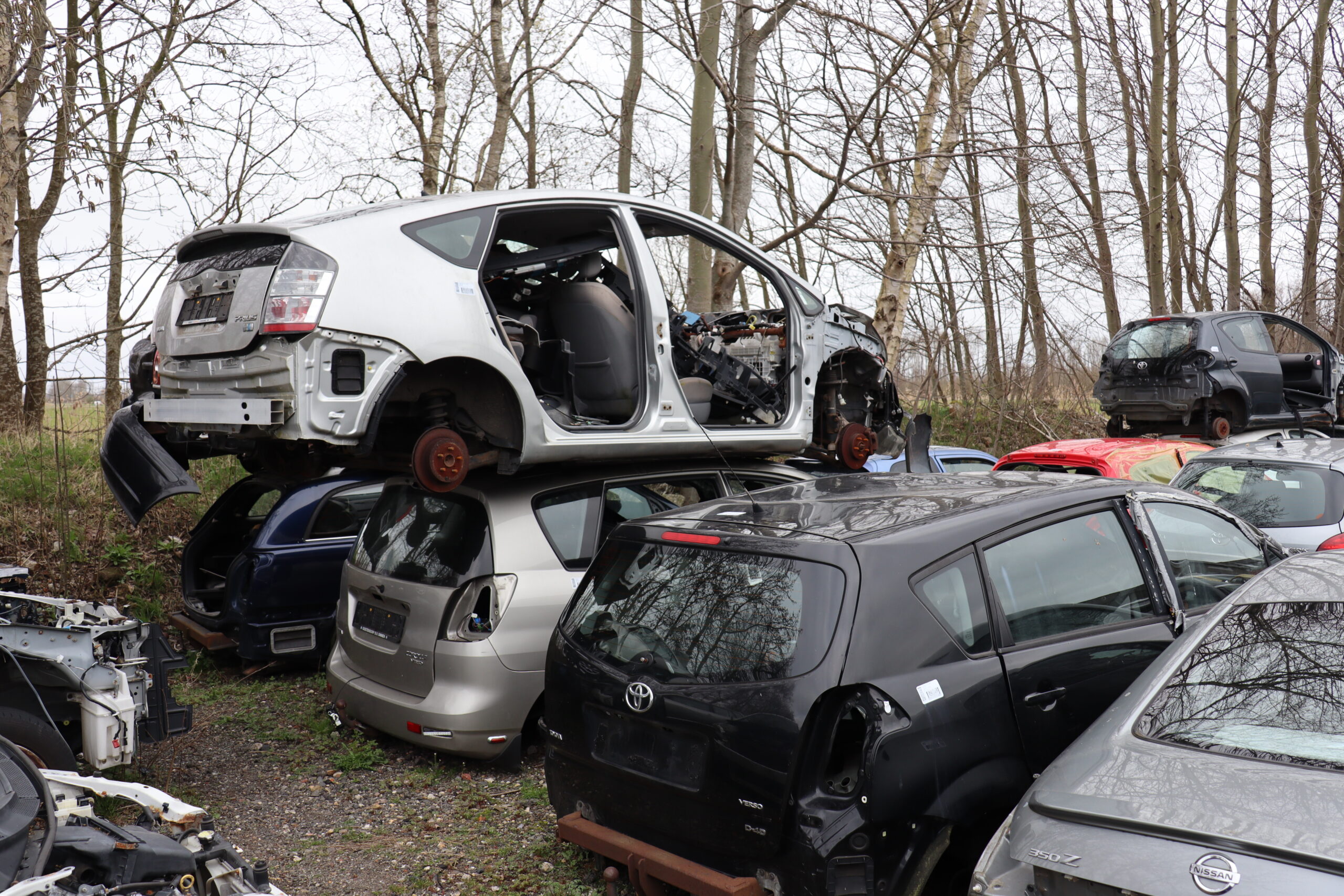Large numbers of old ocean-going vessels continue to be recycled in South Asia. It is cheap and the regulations are minimal. As a result, little attention is given to the environment and safe working conditions. International regulations and ship owners who care for their environment should turn the tide.
Tekst Jens Holierhoek
Around 90 per cent of what we buy is transported by ship. This includes food, clothing, electronics, cars and much more. Without ships, the world economy would look completely different. After around 25 to 30 years of useful service, container ships run out of steam. Then the maintenance and repair costs mount up to such an extent that shipping companies bid farewell to the ship. A popular way of doing this is to send the ship on a one-way journey to South Asia. This is the final destination of around 65 per cent of ships. The valuable parts are stripped in Bangladesh (Chittagong), India (Alang) or Pakistan (Gadani) on so-called “shipbreaking beaches”. After all, 95 per cent of a ship is made of steel which is recycled into new parts. However, there is controversy surrounding Asian shipbreaking beaches. The work is often carried out by low-paid, poorly educated workers who are exposed to hazardous conditions. Furthermore, they cut corners. There is usually no consideration for disposing of oil, asbestos, lead and mercury in an environmentally-friendly way.
China
835 ocean-going ships (around 1.5% of the total international trade fleet) were dismantled in 2017, according to NGO Shipbreaking Platform, an international coalition of environmental and human rights organisations. Together, these dismantled ships represent a huge mountain of material, weighing no less than 27.4 million tons. In addition to the South Asian countries mentioned above (543 ships), ships are mainly dismantled in China (98 ships) and Turkey (133 ships), though the latter countries generally dismantle slightly smaller ships. The modern Chinese and Turkish dismantling yards do not use ‘beaching’.
Ships contain large quantities of steel, copper and aluminium which means that around 97% of a ship can be recycled.
According to the annual report of NGO Shipbreaking Platform, European ships are well-represented on shipbreaking beaches. In 2017, at least 181 ocean-going vessels sailing under a European flag set course for these beaches. These make up 70 per cent of all European ships that were dismantled that year. Greek and German ships, in particular, are overrepresented.
Dry dock
Dutch ship owners deal with their ships differently. When they have ships recycled, it is almost always carried out in a controlled environment. They do not have ships recycled on shadowy beaches, but rather in a dry dock which allows them to be dismantled using cranes. A total of fourteen Dutch-owned ships were recycled this way in 2015, according to figures from NGO Shipbreaking Platform. More recent figures for 2017, from the Royal Association of Netherlands Shipowners (KVNR), even reveal that no ships under a Dutch flag were recycled.According to Niels van de Minkelis, a Nautical and Technical consultant at KVNR, ships owned by Dutch owners are rarely recycled. “The average age of ships reported to KVNR in late 2017 was only twelve and a half years. It means that ships still have a whole life ahead of them after they have been sold on to foreign shipping companies.”
Worldwide regulations
The fact that many ships still end up on shipbreaking beaches in 2019 is all down to the lack of worldwide legislation and regulations. Incidentally, there already is a blueprint for these in the form of the 2009 Hong Kong Convention. This international convention makes provisions for environmentally friendly and safe recycling of old ocean-going vessels. However, there is a problem. It has only been signed by a handful of countries. The Netherlands is about to ratify this treaty. This means that the required minimum number of fifteen countries will be a little closer, even though it is not expected to be ratified in the near future.
The fact that many ships still end up on shipbreaking beaches in 2019 is all down to the lack of worldwide legislation and regulations
The EU Ship Recycling Regulation has been in place since 2013. This regulation has a lot in common with the Hong Kong Convention, but it is slightly less effective. Van de Minkelis: “Maritime shipping is a worldwide industry, as is the recycling of ocean-going vessels. The industry has the most gains from regulations applicable throughout the world, such as the Hong Kong Convention. These are rules that apply to everyone and ensure a level playing field throughout the world. Regional legislation, such as the EU Ship Recycling Regulation, do not offer the same level playing throughout the world.
Improving
Although beaching, a method which is frequently used, is a thorn in the side of environmental, human rights and employment rights organisation, there are improvements on the horizon, according to KVNR. For instance, it pointed out that beaching, which incidentally is not illegal, does not necessarily have to be a bad way of recycling ships. Van de Minkelis: “Various ship recycling facilities in India are catching up enormously and are operating at levels equivalent to the requirements of the Hong Kong Convention. These ship recycling facilities are also opting for an endorsement from the European Union. The maritime industry, including the International Chamber for Shipping (ICS) has even drawn up guidelines for individual shipping companies to follow when they send a ship for dismantling to a ship recycling facility.”
Dutch glory
Although ship recycling around the world is concentrated in just five countries, there are still plenty of smaller ship dismantling companies in other countries. For instance, there are around twenty companies in Europe, which together represent 1.1 million LDT (Light Displacement Tonnage), that recycle ships under the EU Ship Recycling Regulation. Two of these companies are located in the Netherlands – Damen-Verolme in Rotterdam-Botlek and Scheepsrecycling Nederland in ‘s-Gravendeel. Damen-Verolme (capacity up to 52,000 LDT) is able to handle ships with lengths of up to 405 metres, while Scheepsrecycling Nederland (capacity up to 9,300 LDT) handles slightly smaller vessels.
Conscientious
The fact that the European ship recycling firms often dismantle ships properly does not mean that our continent sets the standard across the world, said Tom Peter Blankestijn, Managing Director at the Rotterdam firm Sea2Cradle. Since 2001, Blankestijn and his business partner, Wouter Rozenveld, have been assisting shipping companies to search for ship recycling companies for their end-of-life ships. “You can find bad but also good ship recycling companies all over the world. We work with shipyards in Turkey, Western Europe and China.”
There is a great need for a specialist such as Sea2Cradle to assist shipping companies with the recycling process, according to Blankestijn. “No two ships are the same. Furthermore, all sorts of repairs and renovations are done during the quarter of a century that a ship has been at sea.” That is why Sea2Cradle always looks first at what they are dealing with, so that they know precisely which recycling facility is best suited for dismantling it. They start by drawing up an inventory of the hazardous substances. These substances can range from asbestos in fire-retardant materials to heavy metals such as mercury or radioactive materials in smoke detectors. Sea2Cradle then creates a recycling plan and supervises the dismantling.
Old ship generators are sometimes reused in factories or even to supply energy to villages
The dismantling process then proceeds as follows. Once all the hazardous substances have been removed and properly disposed of or processed, the hull is cut into millions of tiny pieces and milled. This makes it easy to transport and process. Some parts of a ship gain a second life. There is a demand for lifeboats or transformers which are in good condition and have the right certificates. Old ship generators are sometimes reused in factories or even used to supply energy to villages.
Huge job
The process of recycling a ship depends on the size and complexity of the ship. “For instance, car carriers can be fully dismantled and processed in nine weeks, but complex container ships can easily involve three and a half to five months of work. Drilling platforms can take as long as eight months,” said Tom Peter Blankestijn. Ships contain large quantities of steel, copper and aluminium which means that around 97 per cent of a ship can be recycled. “Currently, this is also the maximum percentage,” said Blankestijn. “If you want to achieve a higher percentage, then you have to get shipbuilders involved. They are constantly using different materials that are difficult to recycle, such as insulation material bonded to glass fibre. That three per cent or so of the total weight that we are currently unable to recycle does not seem a lot, but it certainly adds up on a ship weighing 20,000 tons.” This is another sign that ship recycling is making significant advances, but also that there is still also a lot of progress to be made.
Update February 21st
During a meeting of the International Maritime Organisation (IMO), the Netherlands ratified the Hong Kong Convention on 21 February 2019. This convention contains arrangements for the safe and environmentally-friendly dismantling and recycling of ships. Out of the 172 member states of the IMO, the Netherlands is one of the first countries to ratify the convention. Read the full report in Recycling Magazine.




